
Scientists believe they’ve discovered a potentially habitable planet that is ‘pretty close’ to Earth.
Researchers have determined that this planet - known more commonly as TOI-715b - is a ‘super-Earth’ which measures around 1.5 times as wide as our own Blue Planet.
According to a study, published in the Monthly Notices of the Royal Astronomical Society, the sphere circulates a red dwarf star which is both cooler and smaller than our own Sun.
Advert
NASA specialists say that despite TOI-715b being larger than our own home, it takes just 19 Earth days for it to complete an orbit around its star.
A tighter orbit means that a planet ‘crosses the face of its star more often’, which in turn makes them more easily detected and more frequently observed.
It’s also been deduced that the planet is close enough to the red dwarf star to exist within a ‘conservative habitable zone’.
Advert
As per the Space Agency, this means that the distance from the star provides the planet with a suitable temperature for liquid water to form on its surface.
Speaking about the findings, lead study author Dr Georgina Dransfield, a postdoctoral researcher at the University of Birmingham’s School of Physics and Astronomy said: “This discovery is exciting as it’s the first super-Earth from TESS to be found within the conservative habitable zone.
“Additionally, as it’s relatively close by, the system is suitable for further atmospheric investigations.”
So, could Earth dwellers make the move to TOI-715b with some further research?
Advert
Well, maybe not as apparently NASA’s version of ‘fairly close to us’ is just a mere 137 light-years away.

But it’s not all doom and gloom as researchers believe that the system may also harbour a second, Earth-sized planet.
It’s claimed that the smaller globe is probably only ‘slightly larger than Earth’ and that may also harbour inside the ‘conservative habitable zone’.
Advert
If this planet is confirmed by NASA in the future then it will become the smallest habitable-zone planet discovered by the Transiting Exoplanet Survey Satellite (TESS).
TESS was first launched back in April 2018 and its main purpose is to discover exoplanets and worlds beyond our solar system.
“This is allowing us to get a much clearer picture of the diversity of exoplanetary systems orbiting a broad range of stellar types,” said Dr Dransfield of the satellite.
TESS picking up TOI-715b’s quick orbit means that the exoplanet now becomes an optimal candidate for future observations.
Advert
It’s apparently likely that scientists will employ the James Webb Space Telescope to conduct further research into the ‘Super-Earth’.

Webb will also look for evidence of an atmosphere on the planet and will help researchers to further note what makes a planet habitable.
“We really want to know the planet’s mass with high precision to understand if it’s a true super-Earth or a member of the novel category of ocean worlds,” Dr Dransfield continued.
“This will allow us to really shape our follow-up investigations and learn more about exoplanet demographics as a whole.”
In 2026 the European Space Agency’s PLATO mission is set to launch which will see 26 cameras being carried to habitable planets for further study.
“So far, no telescope has been capable of this, but it should be possible within the next decade,” Dransfield explained.
“This will be one of the most anticipated discoveries, as it will begin to show us how common planets truly similar to Earth really are.”
